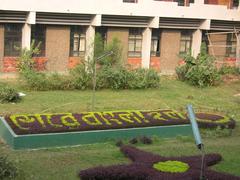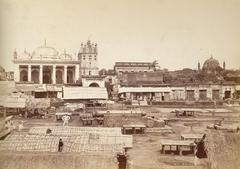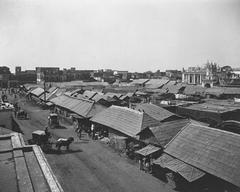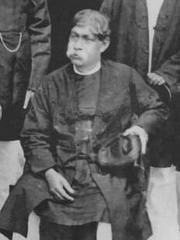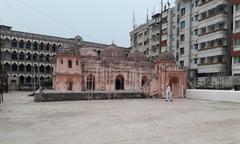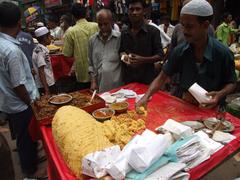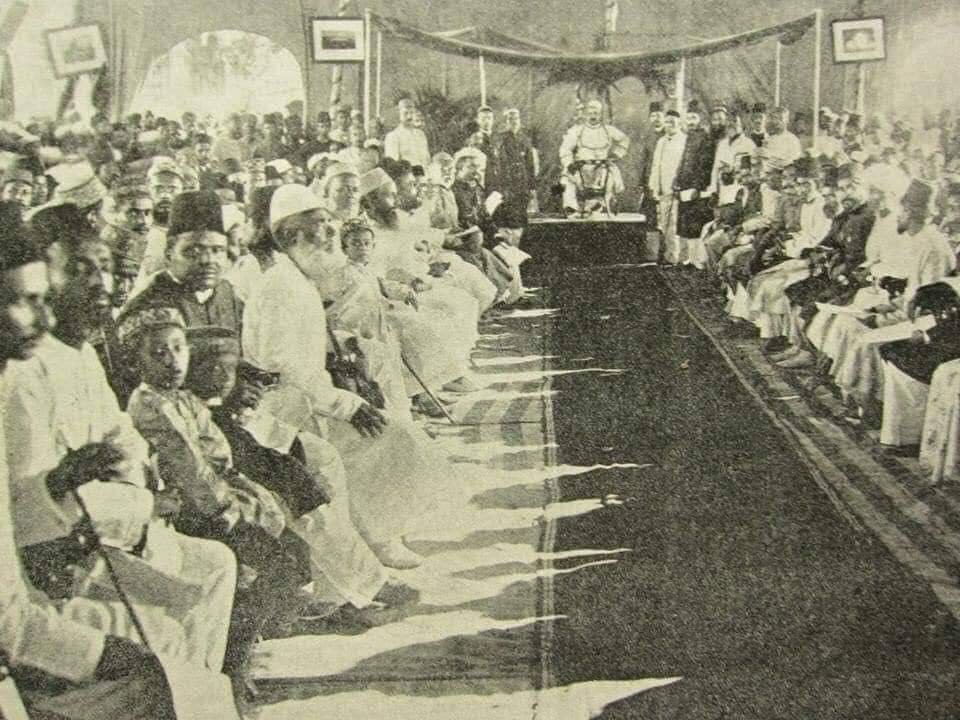
A Comprehensive Guide to Visiting Ahsan Manzil, Dhaka, Bangladesh
Date: 17/07/2024
Introduction
Ahsan Manzil, often referred to as the ‘Pink Palace,’ is one of Dhaka’s most iconic historical landmarks. Located on the banks of the Buriganga River, this architectural marvel serves as a window into the rich cultural and historical tapestry of Bangladesh. The palace, with its distinctive pink hue, is not just a visual delight but also a repository of the history and legacy of the Nawabs of Dhaka. Originally built in 1677 as a trading outpost by Sheikh Enayetullah, the site evolved over centuries, passing through the hands of the French East India Company before finally being transformed into a grand palace by the Dhaka Nawab Family in the 19th century (Banglapedia).
Ahsan Manzil is a blend of Indo-European architectural styles, featuring elements of Mughal and European design. Its grandeur is evident in its majestic dome, tall columns, and spacious verandas. The palace has not only witnessed the opulent lifestyle of the Nawabs but also significant historical events, including the Partition of Bengal in 1905 and the Bangladesh Liberation War in 1971. Today, managed by the Bangladesh National Museum, Ahsan Manzil has been meticulously restored and serves as a museum, attracting visitors from around the world eager to delve into its rich history and architectural splendor.
This comprehensive guide aims to provide you with all the necessary information to make the most of your visit to Ahsan Manzil. From visiting hours and ticket prices to travel tips and nearby attractions, this guide covers it all, ensuring a memorable and enriching experience at Dhaka’s iconic pink palace.
Table of Contents
- Visitor Information
- The Rise of a Palace
- Architectural Grandeur
- A Legacy of Power and Patronage
- Beyond the Walls
- Ahsan Manzil Today
- Frequently Asked Questions
Visitor Information
Ahsan Manzil Tickets and Visiting Hours
Travel Tips
- Arrive early to avoid crowds and enjoy the serene beauty of the palace.
- Consider hiring a local guide to enhance your understanding of the site’s history and significance.
- Wear comfortable shoes as you’ll be doing a lot of walking.
- Photography is allowed, so bring your camera to capture the stunning architecture.
Nearby Attractions
- Lalbagh Fort - A Mughal-era fort offering a glimpse into Dhaka’s historical military architecture.
- Dhakeshwari Temple - The oldest Hindu temple in Dhaka, rich in cultural significance.
- Sadarghat River Port - A bustling port offering a unique look into the city’s life and commerce.
The Rise of a Palace
From French Factory to Nawab’s Residence
The story of Ahsan Manzil begins in 1677 when Sheikh Enayetullah, a prominent Mughal merchant, established a trading outpost on the site. The land was later acquired by the French East India Company, who built a factory there. However, the factory was eventually abandoned, and the property was purchased by Sheikh Khwaja Alimullah, a wealthy businessman and the founder of the Dhaka Nawab Family, in 1830 (Banglapedia).
Khwaja Alimullah built a substantial residence on the property, naming it ‘Rangmahal.’ His grandson, Nawab Khwaja Abdul Ghani, inherited the estate and undertook a significant expansion project in 1872. This expansion transformed Rangmahal into the grand palace we know today as Ahsan Manzil. The palace was named after Nawab Ahsanullah, the son of Nawab Abdul Ghani.
Architectural Grandeur
A Blend of European and Mughal Styles
Ahsan Manzil is a stunning example of Indo-European architecture, seamlessly blending elements of Mughal and European design. The palace is laid out in a classical ‘kashinath’ style, featuring a rectangular plan with a central courtyard. The exterior is characterized by its distinctive pink color, intricate stucco work, and ornate columns. The palace’s most prominent features include:
- The Dome - Ahsan Manzil is crowned by a majestic dome, a common feature in Mughal architecture, symbolizing power and grandeur.
- The Columns - The palace is supported by tall, slender columns adorned with intricate floral motifs, reflecting European architectural influences.
- The Verandas - Spacious verandas encircle the palace, providing shade and offering panoramic views of the Buriganga River.
- The Courtyard - The central courtyard, a hallmark of Mughal architecture, served as a space for gatherings and celebrations.
A Legacy of Power and Patronage
The Nawabs of Dhaka
Ahsan Manzil served as the official residence of the Dhaka Nawab Family for over a century, witnessing the zenith of their power and influence. The Nawabs were renowned for their patronage of the arts, culture, and education. Ahsan Manzil became a hub for intellectual discourse, attracting scholars, artists, and dignitaries from across the region.
The Nawabs played a pivotal role in shaping Dhaka’s social and cultural landscape. They established schools, hospitals, and charitable institutions, contributing significantly to the city’s development. Their legacy is intertwined with the history of Dhaka, and Ahsan Manzil stands as a testament to their enduring impact.
Beyond the Walls
Witness to History’s Turning Points
Ahsan Manzil has witnessed some of the most significant events in Dhaka’s history. From the opulent gatherings of the Nawabs to the tumultuous days of the British Raj, the palace has stood as a silent observer to the ebb and flow of time.
- The Partition of Bengal (1905) - Ahsan Manzil served as a center of political activity during the tumultuous period of the partition of Bengal. The Nawabs played a key role in advocating for the interests of the Muslim community.
- The Birth of Bangladesh (1971) - During the Bangladesh Liberation War, Ahsan Manzil was occupied by Pakistani forces and suffered significant damage. After independence, the palace was nationalized and declared a national monument.
Ahsan Manzil Today
Preserving Heritage, Inspiring Generations
Today, Ahsan Manzil, managed by the Bangladesh National Museum, stands as a proud symbol of Dhaka’s heritage. The palace has been meticulously restored to its former glory, offering visitors a glimpse into the opulent lifestyle of the Nawabs. The museum houses a rich collection of artifacts, including furniture, paintings, and personal belongings of the Nawab family, providing insights into their lives and times.
Ahsan Manzil is not just a historical relic; it’s a vibrant cultural center hosting exhibitions, events, and educational programs. The palace attracts visitors from around the world, eager to experience its architectural splendor and delve into the rich history it embodies. A visit to Ahsan Manzil is a journey through time, offering a glimpse into a bygone era and celebrating the enduring legacy of the Nawabs of Dhaka.
Frequently Asked Questions
- What are the visiting hours for Ahsan Manzil? Ahsan Manzil is open from 10:30 AM to 5:30 PM from Saturday to Wednesday. It is closed on Thursdays and open from 3:00 PM to 7:30 PM on Fridays.
- How much are the tickets for Ahsan Manzil? Tickets are priced at BDT 200 for foreigners, BDT 50 for citizens of SAARC countries, and BDT 20 for Bangladeshi nationals.
- Is photography allowed inside Ahsan Manzil? Yes, photography is allowed, so bring your camera to capture the stunning architecture.
- Are guided tours available? Yes, guided tours are available and highly recommended to enhance your understanding of the site’s history and significance.
Conclusion
A visit to Ahsan Manzil is more than just a tour of a historical site; it’s a journey through time, offering a glimpse into the opulent lifestyle of the Nawabs of Dhaka and the rich cultural heritage of Bangladesh. The palace stands as a testament to architectural ingenuity and historical significance, blending Mughal, European, and local Bengali styles in a unique fusion. Whether you’re marveling at its grand dome, exploring its intricate interiors, or pondering its role in significant historical events, Ahsan Manzil promises an enriching experience.
Managed by the Bangladesh National Museum, Ahsan Manzil today serves not only as a museum but also as a vibrant cultural center, hosting exhibitions, events, and educational programs. It continues to inspire generations, preserving the legacy of the Nawabs and offering valuable insights into Dhaka’s historical and cultural landscape. As you plan your visit, remember to check for guided tours and special events to enhance your experience.
In conclusion, Ahsan Manzil is a must-visit destination for anyone interested in history, architecture, and culture. Its unique blend of styles, rich historical context, and the stories it holds make it a cornerstone of Dhaka’s heritage. Don’t miss the opportunity to explore this iconic palace and immerse yourself in the fascinating history it embodies.
References
- Banglapedia - Ahsan Manzil. (n.d.). Retrieved from http://en.banglapedia.org/index.php?title=Ahsan_Manzil





